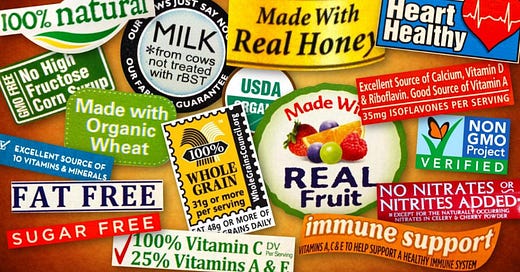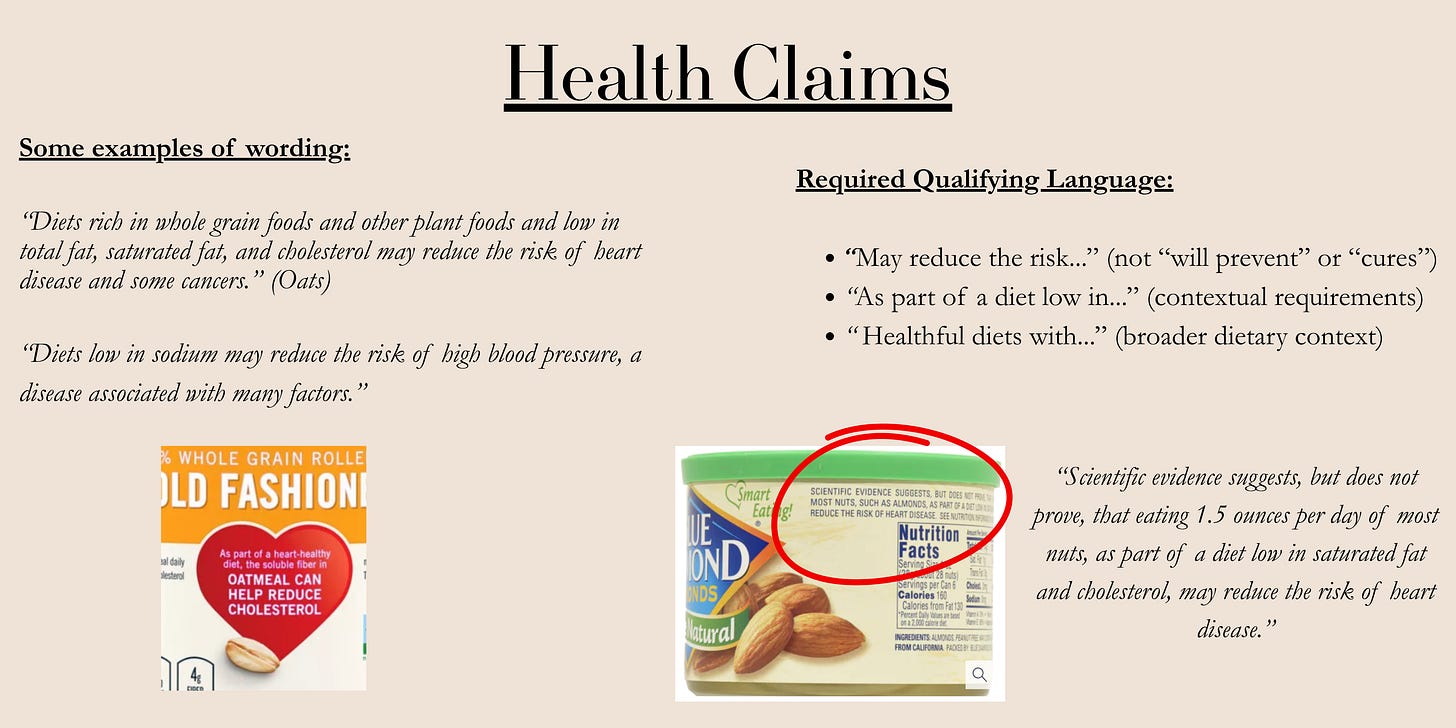Hi Noosers! Anne & Avery, here. Our view on health is simple: small daily actions add up. The basics are the priority: real food, movement you enjoy, and habits that support you. Anne (Registered Dietitian) and Avery (Health Coach) write Monday Noosletters based on research and our experiences — because at the end of the day, we all want to know what everyone else is doing, perhaps due to our innate curiosity around human behavior. We are mothers, friends, and athletes who want to share our knowledge and empower our readers to take their health into their own hands. Every first Monday of the month is free, but if you’d like to upgrade to a paid subscription to receive weekly Noosletters, we’d be thrilled!
Happy Monday, Noosers! We hope everyone had a wonderful weekend and Father’s Day. Today we are diving into something that may be on a lot of parents’ minds (and adults in general) as you grocery shop for the week. How many times are you drawn to a certain food product in the grocery story because of what the packaging says? Whether something is being marketed as healthy, low sodium, sugar free or part of a “balanced diet,” we’ve all seen language on labels that make us more keen to buy an item. But what do these claims actually mean?!
When I (Avery) heard what Anne had up her sleeve for today’s Noosletter, the image of a young Brad Pitt from the 1995 classic, “Seven,” popped into my head (a demented first thought, I know 🤣). If you’ve seen this crime thriller, you know the final scene features Brad’s character peering into a box, terrified, screaming “what’s in the box?!”
Naturally, when I think of front of package claims on food products, this scene is what comes to mind (and Brad Pitt) — but today’s post will not be scary nor will it feature Gwyneth Paltrow’s head (if you’ve seen the movie, you get it). When you look at a packaged food, be curious about “what’s in the box” (ingredients!), rather than seeing the word “healthy” and throwing it in your grocery cart without further thought. Enjoy today’s post and learn what some of the popular claims are and what they actually mean — and our advice at the end of the day. Be like Brad Pitt, and take a second to ask yourself what’s in the box!
what kinds of health claims are there?
“Diet-related chronic diseases in the U.S. are the leading causes of death and disability….Healthy eating patterns, which include foundational foods like fruits, vegetables, fat-free and low-fat dairy, and whole grains, are associated with improved health, such as reduced risk of cardiovascular disease, type 2 diabetes, certain types of cancers, and being overweight or obese. Providing informative and accessible food labeling empowers consumers and may help foster a healthier food supply for all if some manufacturers voluntarily reformulate food products to meet the updated criteria.”-FDA
Have you ever thought about the words/claims you see on the front of a food label? Chances are, they’ve maybe even swayed your choices. Research shows that consumers viewed products as being healthier simply if they presented nutritional or health-related claims. The mere presence of any health language creates a “halo effect” that influences our choices. But what do these bright, eye-catching words even mean? We’re curious, do you let those enticing words on the front of the package guide your decisions, or do you flip it over to see what’s really inside?
There is so much that goes into why we buy what we buy, but today, we’re going to take a look at those claims on the front of a label and what they really mean.
Here in the US on the front of packaged foods we have claims, labels, and symbols.
The three categories of claims that can be used on food and dietary supplement labels are health claims, nutrient content claims, and structure/function claims. Let’s break down what each of these actually means and how much science is really behind them.
1. Health Claims
A label featuring a health claim relates a specific food (or food component) to lowering the risk of disease or health-related condition. For an authorized health claim to be approved by the FDA, the agency says “there must be significant scientific agreement (SSA) among qualified experts that the claim is supported by the totality of publicly available scientific evidence for a substance/disease relationship.” The FDA has approved only 12 health claims. Health claims are the strongest of all three claims.
2. Nutrient Content Claims
Nutrient content claims describe the nutritional content of a product as “free” or “low.” You’ve probably seen labels with sugar free, fat free, or low sodium. These claims can only be made for nutrients with an established percent daily value (%DV). The most recent update to the nutrient content claims is the “healthy” claim. The claims are aligned with current nutrition science, the Dietary Guidelines for Americans, and the updated Nutrition Facts label, which requires the declaration of added sugars. The FDA is also continuing to explore development of a symbol that manufacturers could use on food labeling to show that a product meets the criteria for the “healthy” claim. Companies have until February 25, 2028 to comply.
To bear the “healthy” claim, a food product needs to:
Contain a certain amount of food from at least one of the food groups or subgroups (such as fruits, vegetables, fat-free and low-fat dairy etc.) recommended by the Dietary Guidelines.
Adhere to specified limits for the following nutrients: saturated fat, sodium, and added sugars.
Nuts and seeds, higher fat fish (such as salmon), certain oils, and water are examples of foods that did not qualify for the “healthy” claim before, but are foundational to a healthy eating pattern and recommended by the Dietary Guidelines. These foods now qualify to bear the “healthy” claim.
3. Structure/Function Claims
Structure/function claims may describe the role of a nutrient or dietary ingredient intended to affect the normal structure or function of the human body. For example, “calcium builds strong bones.” They cannot suggest any association with disease — not even weak associations. They must stay focused on normal body functions only. Companies tend to like structure/function claims because there is no FDA pre-approval needed and the company controls the evidence standard. For supplements specifically, there’s also a simple 30-day notification process rather than lengthy approval procedures. These are the weakest claims and are the most common on supplements and functional foods because they're easiest to get approved.
What’s Allowed:
“Supports immune system function”
“Maintains cardiovascular function”
“Helps maintain joint mobility”
What’s NOT Allowed:
“May help with arthritis” (disease reference)
“Supports immune system during cold season” (implies illness)
“May reduce inflammation associated with heart disease” (disease reference)
Any dietary supplement with a structure/function claim MUST include:
"This statement has not been evaluated by the Food and Drug Administration. This product is not intended to diagnose, treat, cure, or prevent any disease."
Now, after reading all this, you might be thinking: “Great, so I need to become a food label lawyer just to buy groceries?!” Not at all. The goal isn’t to turn every shopping trip into a research project or to make you second-guess every food choice. But before I give you the simple answer, let me ask: why did we just spend all this time breaking down claims?
Keep reading with a 7-day free trial
Subscribe to NooS Substack to keep reading this post and get 7 days of free access to the full post archives.










